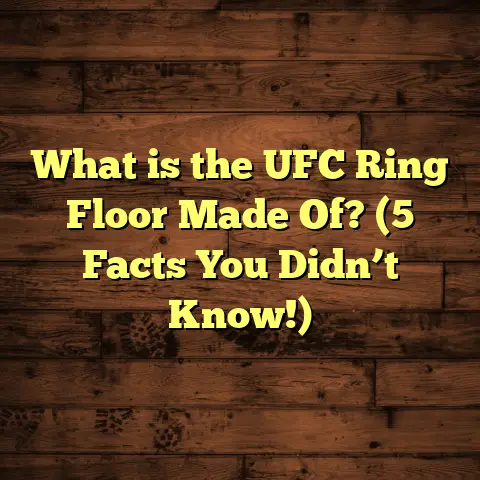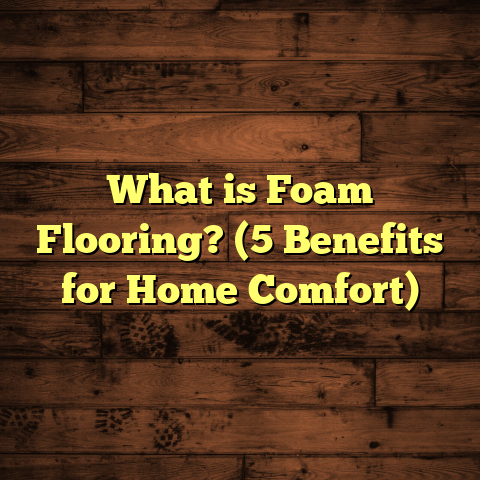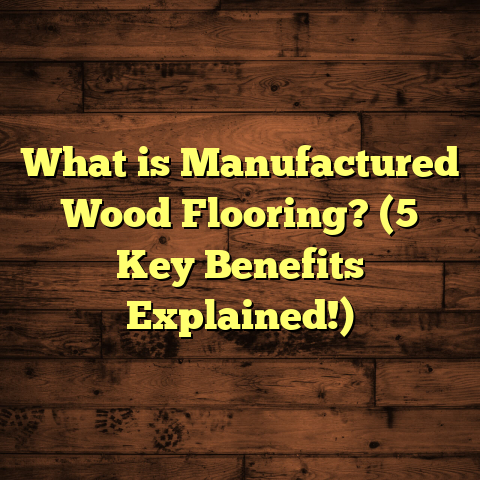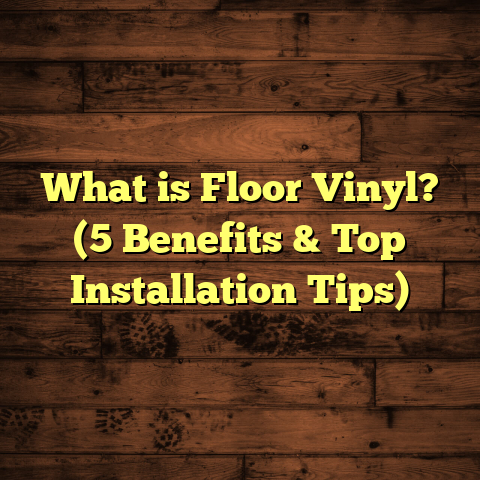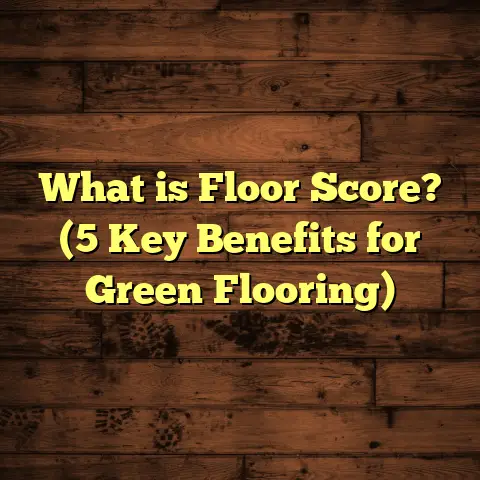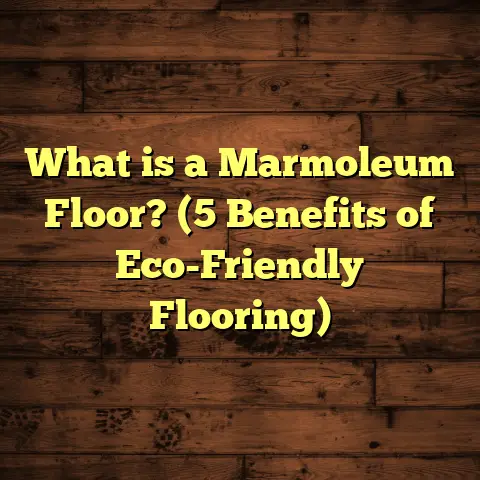What is Laminate Flooring vs Vinyl? (5 Key Differences Revealed!)
I still remember the first time I stood inside a brand-new home, running my fingers over the smooth flooring. I was mesmerized by how the floor looked like real wood but wasn’t as delicate or expensive as hardwood. At that moment, I was deciding between laminate and vinyl flooring for my own project. Both had their perks, but I didn’t want to make a costly mistake. Since then, I’ve installed dozens of floors in various homes and commercial spaces and learned a lot about what makes laminate flooring different from vinyl. Let me take you through everything I know about these two popular options so you can make a choice that fits your home, budget, and lifestyle perfectly.
What Are Laminate Flooring and Vinyl Flooring?
Understanding what laminate and vinyl flooring truly are is the first step to understanding how they differ.
Laminate Flooring: The Layered Wood Look-Alike
Laminate flooring is a multi-layer synthetic flooring product fused together through a lamination process. The top layer is a clear protective wear layer that guards against scratches and fading. Underneath that is a high-resolution photographic layer that mimics the appearance of natural wood, stone, or other materials. Beneath this image layer lies a core made of high-density fiberboard (HDF), usually composed of compressed wood fibers bonded with resins.
The bottom layer is a stabilizing backing that prevents moisture from warping the floor and adds dimensional stability. When you walk on laminate, you feel a firm surface with a slight “give” because of the fiberboard core.
What I find interesting is how laminate flooring evolved over the years. Early versions had a flat surface and could look fake easily. Now, manufacturers use embossing techniques to add texture matching the wood grain pattern on the photographic layer — making it look quite realistic. Thickness varies typically between 6mm to 12mm, with thicker planks offering better sound insulation and durability.
Vinyl Flooring: The Flexible Waterproof Alternative
Vinyl flooring is made primarily from polyvinyl chloride (PVC), a type of plastic. It comes in several formats: sheet vinyl rolls, vinyl tiles, and luxury vinyl planks (LVP). Vinyl flooring has several layers as well—a backing layer for stability, a core that can be flexible or rigid depending on the type, a printed design layer, and a wear layer on top for protection.
Unlike laminate, vinyl is inherently waterproof since it’s plastic-based. That means no swelling or warping when exposed to moisture, which immediately makes vinyl popular in kitchens, bathrooms, basements, and laundry rooms.
Vinyl thickness ranges from about 2mm to 8mm depending on quality and type. Luxury vinyl planks often have a rigid core (WPC or SPC) that mimics the feel of hardwood more closely than traditional sheet vinyl.
1. Material Composition and Durability: What Will Last Longer?
Let’s talk about what these floors are made of because it affects how they perform in real life.
Laminate Flooring Composition
Laminate flooring’s core material is wood-based high-density fiberboard (HDF). This makes it rigid but also vulnerable to water damage if exposed for too long. I’ve seen cases where spills left unattended caused the edges of laminate planks to swell and curl—something no one wants in their living room.
The wear layer varies by rating from AC1 to AC5: AC3 is standard for most residential applications, meaning it can handle moderate foot traffic in homes. Commercial spaces often require AC4 or AC5 ratings due to heavier use.
Vinyl Flooring Composition
Vinyl flooring is 100% synthetic and waterproof. The core can vary:
- Flexible vinyl: Soft and pliable, found mostly in sheet vinyl.
- Rigid vinyl (WPC/SPC): Wood or stone plastic composite cores that add toughness and stability.
I’ve installed SPC vinyl planks in restaurant kitchens where spills are constant and heavy foot traffic wears down everything else quickly. The floors held up remarkably well over years without signs of damage.
Durability Comparison Based on Real Use
- Laminate generally lasts 15-25 years with proper care but can be damaged by water.
- Vinyl lasts 10-20 years depending on wear layer thickness but handles moisture far better.
In my experience working with homeowners in humid climates like Florida or coastal California, vinyl often outperforms laminate because moisture control indoors can be challenging.
2. Installation Methods and Timeframes: How Long Will It Take?
One question I get all the time: “How long will my new floor take to install?” It depends on the product but here’s what I’ve seen repeatedly on projects:
Laminate Installation
Laminate uses a click-lock system with tongue-and-groove edges that snap together over an underlayment. Because it doesn’t require glue or nails, installation goes quickly if the subfloor is level.
For an average 200-square-foot room, professional installers usually take 1-2 days from prepping the subfloor to finishing touches.
Vinyl Installation
Vinyl installation varies by type:
- Sheet vinyl: Requires adhesives and precise cutting around corners and outlets; can take longer.
- Vinyl planks (LVP): Often uses click-lock systems similar to laminate but sometimes requires acclimating the material to room conditions for 24-48 hours before installation.
The last kitchen I worked on had roughly 300 square feet of LVP installed in about 1.5 days including prep work.
Subfloor Preparation
Both laminate and vinyl require clean, flat subfloors free of moisture issues. Uneven floors can cause problems like creaking or plank separation later on.
I always spend extra time on leveling to avoid callbacks later—trust me, it pays off.
3. Cost Comparisons: What’s the Investment?
Money talks in any home renovation project. Here’s what you can expect for materials and installation costs based on recent projects I’ve managed across different U.S. regions.
| Flooring Type | Material Cost per Sq Ft | Installation Cost per Sq Ft | Total Cost for 500 Sq Ft |
|---|---|---|---|
| Laminate | $1 – $5 | $1 – $3 | $1,000 – $4,000 |
| Vinyl (LVP) | $2 – $7 | $2 – $4 | $2,000 – $5,500 |
| Vinyl (Sheet) | $1 – $4 | $1.50 – $3 | $1,250 – $3,500 |
Prices vary widely depending on brand, wear layer thickness, design complexity, region labor rates, and floor prep needs.
Using FloorTally for Budget Clarity
For me personally, FloorTally has become an essential tool for estimating costs before starting any project. It factors in local labor rates—something many DIY calculators miss—and even adds waste percentages so you don’t run short on materials mid-job.
Once I enter project dimensions and select materials, FloorTally instantly shows me total estimated costs broken down by labor and materials. This helps clients understand where their money goes without any surprises later.
If you ever want precise budgeting help based on your location and style choices, checking out tools like this might save you headaches.
4. Appearance and Design Options: What Will Your Floor Look Like?
If you’re like me, aesthetics matter just as much as function. Luckily both laminate and vinyl have come a long way in mimicking natural materials.
Laminate Designs
Thanks to high-res photographic layers combined with embossing textures:
- You can get anything from rustic oak to exotic Brazilian cherry looks.
- Thicknesses around 8-12mm add realism through depth perception and sound dampening.
- Some laminates feature beveled edges for authentic plank separation appearance.
I once helped a client who wanted an affordable floor that looked like reclaimed barn wood—laminate nailed it at less than half the cost of real hardwood.
Vinyl Designs
Vinyl shines when it comes to versatility:
- Sheet vinyl offers huge design variety including patterns like tile mosaics or stone slabs.
- Luxury vinyl planks have textured surfaces embossed with wood grain or stone textures.
- Some brands even produce vinyl floors with UV-cured urethane coatings for enhanced durability.
I remember installing luxury vinyl plank flooring in a boutique hotel lobby where guests kept asking if it was real wood—it wasn’t!
Both types allow customization with color tones from light maple to deep mahogany or even graywashed modern looks popular today.
5. Maintenance and Longevity: Keeping Your Floor Looking Good
How much work do you want to put into keeping your floor beautiful? Here’s what I tell clients based on years of experience:
Laminate Maintenance
- Sweep or vacuum regularly to prevent dirt scratches.
- Wipe spills immediately—standing water can cause swelling.
- Avoid wet mopping; use lightly damp cloths instead.
- No waxing or polishing; the wear layer doesn’t respond well.
If you care for it properly, your laminate floor should last 15+ years without looking worn out.
Vinyl Maintenance
- Vinyl is more forgiving—wet mopping with mild cleaners is safe.
- Resistant to stains; even pet accidents clean up easily without damage.
- Avoid abrasive scrubbing pads that could wear down topcoat.
In homes with kids or pets where messes happen often, I usually recommend vinyl because it handles abuse better long term.
A Deep Look Into Water Resistance
One area where these two differ dramatically is water resistance—and I’ve had firsthand experience witnessing this difference play out strongly.
Laminate Water Sensitivity
When laminate gets wet for extended periods—say a spill left overnight or flooding—the fiberboard core absorbs moisture causing swelling at edges called “peaking” or “cupping.” This ruins not only appearance but structural integrity.
I once had to replace an entire bedroom floor after a plumbing leak went unnoticed for days under laminate because the damage was irreversible by then.
Vinyl’s Waterproof Advantage
Vinyl’s plastic makeup means no swelling no matter how wet it gets. This makes it an ideal choice for bathrooms or basements prone to humidity or occasional flooding.
For example:
- In one basement remodel project prone to seepage during heavy rains, we installed luxury vinyl plank flooring that remained flawless even after multiple water intrusions—something laminate wouldn’t have survived without damage.
Sound Insulation and Feel Underfoot
Comfort and acoustics are often overlooked when choosing floors but matter greatly in homes with kids or open floor plans.
Laminate Sound Profile
Laminate can sound hollow or clicky when walked on unless paired with quality underlayment materials like cork or foam pads that absorb impact noise.
I recommend at least 6mm thick underlayment beneath laminate for bedrooms or living spaces to reduce echoing footsteps.
Vinyl Sound Profile
Vinyl tends to feel softer underfoot due to its flexible nature even without extra padding. It also absorbs sound better naturally compared to laminate which helps reduce noise transfer between floors—especially useful in apartment buildings or multi-story homes.
Environmental Impact: Which One Is More Eco-Friendly?
Sustainability is becoming more important for many homeowners including myself as I try to reduce my environmental footprint.
- Laminate: Made partially from wood fibers sourced from trees; some brands use recycled content but most cores rely on virgin fiberboard. Manufacturing involves formaldehyde-based resins which have raised concerns although newer products meet safer emission standards.
- Vinyl: Made from PVC plastic which is derived from fossil fuels; production emits toxic chemicals including dioxins if not carefully controlled. Some brands offer phthalate-free options and recycling programs but overall vinyl carries a higher environmental cost compared to wood-based products.
If environmental impact influences your decision, look for certifications such as FloorScore or GREENGUARD for low VOCs (volatile organic compounds) regardless of material choice.
Case Study: Family Home in Seattle
Last year I helped a family in Seattle decide on flooring for their newly built home with three kids under age ten—a tough crowd!
Their priorities:
- Durability against spills and scratches
- Water resistance due to rainy climate
- Affordable installation within $10k budget
We compared laminate vs mid-range luxury vinyl plank options across 1,200 square feet covering living room, kitchen, and hallways.
Laminate option:
- Materials cost: $3 per sq ft
- Installation cost: $2 per sq ft
- Total: approximately $6,000
Vinyl option:
- Materials cost: $4 per sq ft
- Installation cost: $2.50 per sq ft
- Total: approximately $7,800
The family chose vinyl despite higher upfront cost because:
- Better water resistance given Seattle’s wet weather
- Softer feel underfoot for kids playing
- Easier maintenance over time
It’s been eight months now with zero issues reported—even after multiple muddy boots tracked inside!
Personal Tips From My Experience
Here are some things I’ve learned over years working hands-on with these floors:
- Choose laminate if: You want a wood-like feel on a budget and your space is dry—bedrooms or living areas work great.
- Choose vinyl if: Moisture is an issue or you want soft comfort—bathrooms, kitchens, basements excel here.
- Invest in quality: Both laminate and vinyl come in many price points; spending extra on thicker wear layers pays off long term.
- Don’t skimp on subfloor prep: Uneven floors cause squeaks or plank separation no matter which type you choose.
- Use tools like FloorTally before buying anything so your budget includes everything from waste factors to labor costs accurately.
Frequently Asked Questions I Get From Clients
Q: Can I install laminate or vinyl over concrete?
A: Yes! Both can go over concrete as long as it’s dry, level, and clean. Moisture barriers may be required especially under laminate to avoid water damage from below.
Q: Which is better for radiant heating?
A: Vinyl generally performs better with radiant heat due to flexibility but some laminates are compatible if manufacturer-approved underlayment is used.
Q: Can I install these floors myself?
A: Absolutely! Both laminate and vinyl plank floors offer DIY-friendly click-lock systems but require patience for proper subfloor prep and accurate cuts around corners.
Final Thoughts Based on My Journey With Floors
Walking through homes where I’ve installed both laminate and vinyl floors reveals one thing clearly—there isn’t one perfect answer for everyone. Each has strengths tailored to specific needs:
Laminate offers great looks at an affordable price but demands dry conditions. Vinyl offers unmatched waterproof performance combined with soft comfort but usually comes at a slightly higher price point.
If you ask me now after years of work and research? For most family homes dealing with real-life messes—vinyl wins slightly due to ease of maintenance and moisture resistance. But if budget constraints are tight and you want a classy wood look in dry spaces? Laminate still holds strong ground.
Whatever you pick, investing time in research upfront—including using budgeting tools like FloorTally—and choosing quality products pays off with floors that look great and last years without hassle.
Got questions about your project? Feel free to reach out—I’m always happy to share what works best based on real-world experience!
